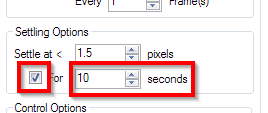David,
Thanks for the logs. There is a lot going on there.
First, I think your main issue is that you have SGP configured with a settle time of zero or else you don't have the settle option checked, I'm not sure which.
Image may be NSFW.
Clik here to view.
When the option is not checked or the value is 0 seconds, then settling will be considered to be done any time the guide star happens to fall within 1.5 pixels of the lock position, even if it is bouncing all over the place (which it is!)
Another problem I see is that in phd2 you have selected spiral dither and dither RA only, and in SGP you have selected Extreme Dither (5 pixels). The combination of spiral dither and dither RA only will tell PHD2 to dither with this sequence of relative lock position coordinates: (0,0) -> (+5,0) -> (-5,0) -> (-10,0) -> (+10,0) -> (+15,0) -> (-15,0) ... So you can see that the dither steps will become quite large. If you need to keep dither RA only, you should either go to the default (random) dither, or use a much smaller dither size, like Small Dither or Medium Dither. (I'd recommend using the default random dither in your case, not spiral.)
The guide logs show a significant amount of RA oscillation and dec backlash. If you'd like to discus how to diagnose those problems, it would be a better topic for the PHD2 forum since it is unrelated to SGP.
To close the loop on 2.6.2 vs 2.6.1 vs 2.6.2dev3: that's a red herring. With settle time set to zero or disabled and the large random ra oscillations and dec backlash, your results are not deterministic and any difference between the PHD2 versions is coincidental.
Going forward I'd start by fixing the settling settings in SGP and go back to default random dither in PHD2. If you're guiding results are still not adequate after that, we can dig into it more on the phd2 forum.
Hope that helps,
Andy
